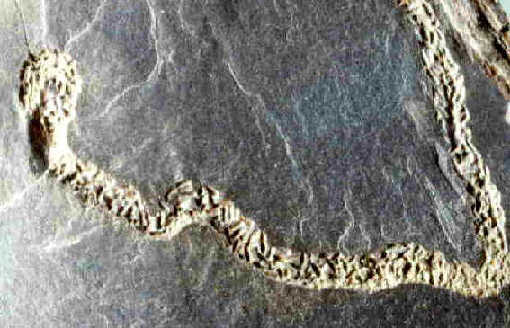Revision des Ichnotaxon Tomaculum Groom,
1902 Von Klaus-H. Eiserhardt, Hamburg, Lutz Koch, Ennepetal, und Wolf L. Eiserhardt, Hamburg Mit 8 Abbildungen, 2 Diagrammen und 1 Tabelle Eiserhardt, K.-H., Koch, L. & Eiserhardt, W. L. (2001): Revision des Ichnotaxon Tomaculum Groom, 1902. [Revision of the ichnotaxon Tomaculum Groom, 1902] – N. Jb. Geol. Paläont. Abh., 221: 325-358; Stuttgart. Abstract: Tomaculum Groom,
1902 was not only designated to typify single fecal pellets of cylindrical outline. An
essential part of the protologue is the special mode of accumulation, which took place on
the sediment surface, in charactristic patches, strings and/or bands. Thus, Tomaculum ist
senior synonym of Syncoprulus Richter & Richter, 1939a, who noticed this
synonymy immediately (1939b). "Coprulus n.g." had been established by
Richter & Richter (1939a) as informal name only, for single coprogenic pellets of
cylindicral shape. This is the reason why Coprulus should not be considered as
junior synonym of Tomaculum. Moreover, Coprulus is out of any
nomenclatorical state because of missing type species. In contrast to the current use Tomaculum
should not serve for "composite trace fossils" with cylindrical or granular Coprulus-like
constituents, e.g. pellet-filled burrows similar to Alcyonidiopsis Massalongo,
1856. Burrows of the Alcyonidiopsis type have been originated infaunally whereas Tomaculum
pellets and strings are the excrementa of an epibenthic animal comparable to the
excremental behaviour of gastropods.
Zusammenfassung: Das
Ichnogenus Tomaculum Groom, 1902 bezeichnet nicht nur bestimmte fossile
Einzel-Kotpillen. Integraler Bestandteil des Protologes ist auch deren besondere
kumulative Ablage auf der Sedimentoberfläche, d.h. die Anordnung in charakteristischen
Paketen, Schnüren und Bändern. Damit ist Tomaculum das ältere Synonym von Syncoprulus
Richter & Richter, 1939a. Diese Synonymie wurde bereits von Richter & Richter
(1939b) zutreffend festgestellt. "Coprulus n.g." ist von Richter &
Richter (1939a) als informelle Bezeichnung für Einzelpellets eingeführt worden und damit
kein jüngeres Synonym von Tomaculum. Wegen fehlender Typusart hat Coprulus
zudem keinen taxonomischen Stand. Entgegen der gängigen Klassifikationspraxis sollte Tomaculum
daher nicht als "composite trace fossil " auf formähnliche granulare
Füllkörper anderer Ichnotaxa (z.B. Wurmbauten) angewendet werden. Tomaculum
paßt allein schon der epibenthischen Lebensweise seines Erzeugers wegen nicht als
kompositer Bestandteil infaunaler Spurentaxa wie Alcyonidiopsis Massalongo, 1856.
|
